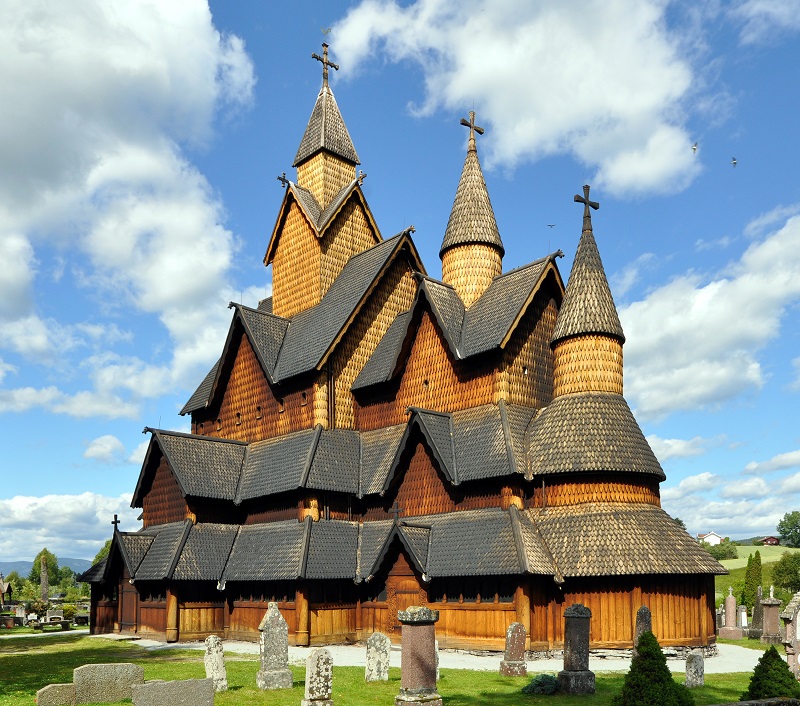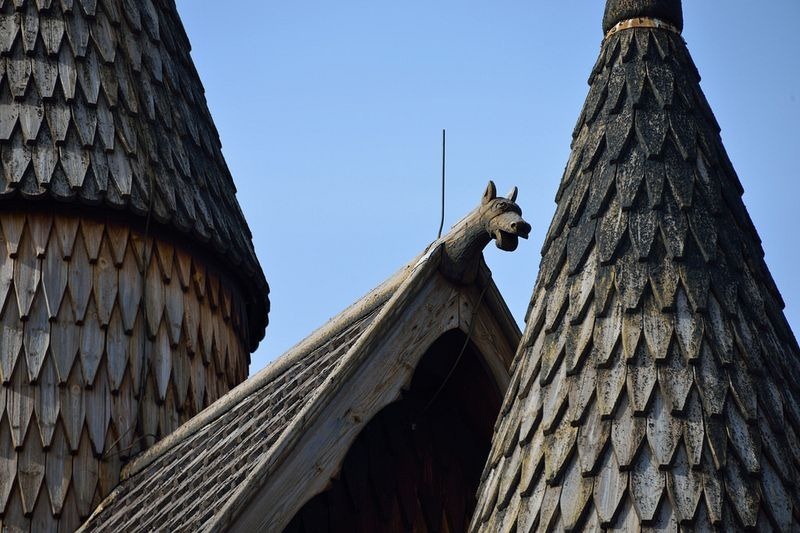Heddal stave church, Norway
Heddal stave church was constructed at the start of the 13th century and is the largest church of its kind in Norway. It is a triple nave stave church made entirely of timber, save for a stone base.
Stave churches are medieval Christian churches prevalent across north-western Europe. They are characterised by the ‘staves’, or thick timber posts, which hold them in place. They adopt the same woodworking techniques as the Viking shipbuilders, using expertly crafted joints and joins rather than nails or glue.
Heddal stave church is built around 12 large and 6 smaller Norwegian pine staves, as well as four carved entrance portals, and an external gallery which circles the building. Inside, there is a ‘Bishop’s Chair’ which dates from the 13th century, as well as wall-mounted ‘rose’ paintings from 1668 and ornate carvings relating pagan myths and Christian parables.
The church suffered considerable damage during the Reformation, but restoration was undertaken from 1849-51. It was at this time that the church bells were removed and placed in the external bell-tower to reduce the load on the timber structure. Another significant restoration project was required in the 1950s.
Throughout most of the year the church is still in use as Heddal’s main parish church.
[edit] Related articles on Designing Buildings Wiki
Featured articles and news
RTPI leader to become new CIOB Chief Executive Officer
Dr Victoria Hills MRTPI, FICE to take over after Caroline Gumble’s departure.
Social and affordable housing, a long term plan for delivery
The “Delivering a Decade of Renewal for Social and Affordable Housing” strategy sets out future path.
A change to adoptive architecture
Effects of global weather warming on architectural detailing, material choice and human interaction.
The proposed publicly owned and backed subsidiary of Homes England, to facilitate new homes.
How big is the problem and what can we do to mitigate the effects?
Overheating guidance and tools for building designers
A number of cool guides to help with the heat.
The UK's Modern Industrial Strategy: A 10 year plan
Previous consultation criticism, current key elements and general support with some persisting reservations.
Building Safety Regulator reforms
New roles, new staff and a new fast track service pave the way for a single construction regulator.
Architectural Technologist CPDs and Communications
CIAT CPD… and how you can do it!
Cooling centres and cool spaces
Managing extreme heat in cities by directing the public to places for heat stress relief and water sources.
Winter gardens: A brief history and warm variations
Extending the season with glass in different forms and terms.
Restoring Great Yarmouth's Winter Gardens
Transforming one of the least sustainable constructions imaginable.
Construction Skills Mission Board launch sector drive
Newly formed government and industry collaboration set strategy for recruiting an additional 100,000 construction workers a year.
New Architects Code comes into effect in September 2025
ARB Architects Code of Conduct and Practice available with ongoing consultation regarding guidance.
Welsh Skills Body (Medr) launches ambitious plan
The new skills body brings together funding and regulation of tertiary education and research for the devolved nation.
Paul Gandy FCIOB announced as next CIOB President
Former Tilbury Douglas CEO takes helm.
UK Infrastructure: A 10 Year Strategy. In brief with reactions
With the National Infrastructure and Service Transformation Authority (NISTA).

























Comments